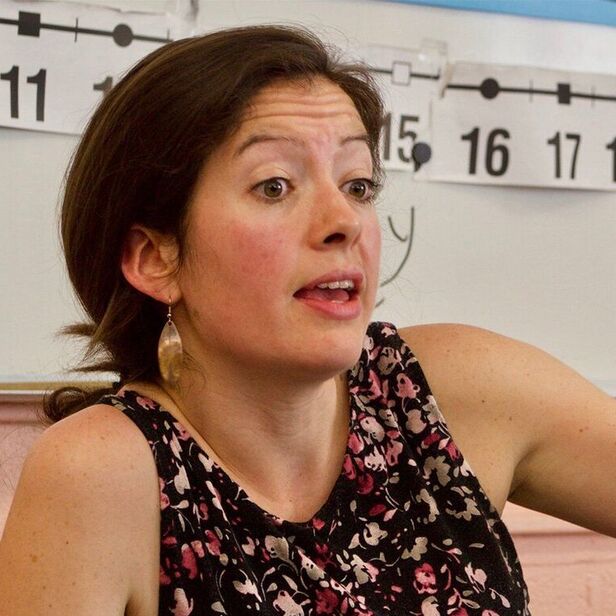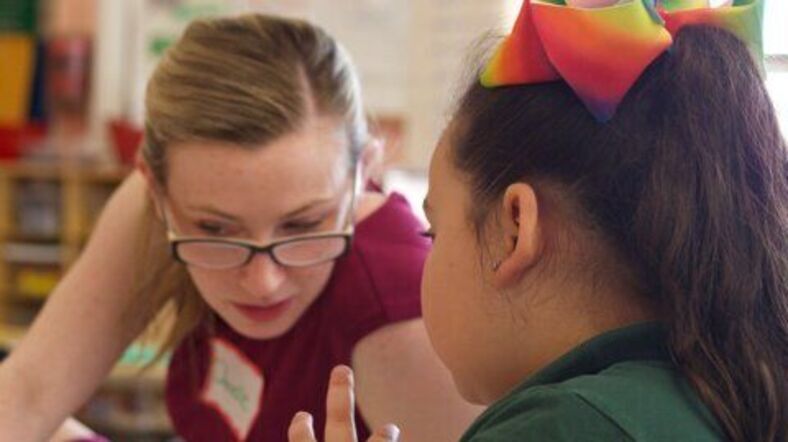Building Blocks: Modeling
Important teaching practices are modeled for teacher-candidates and broken down into component parts so teacher-candidates understand “why” they work.

Important teaching practices are modeled for teacher-candidates and broken down into component parts so teacher-candidates understand “why” they work.
We learn by example. Virtually no one would dispute this claim. But how we learn from example is less well understood, at least from the perspective of learning science. There are two key points to keep in mind.
First, our immediate cognitive powers are limited — understanding new ideas will be impeded if we are confronted with too much information at once. This is particularly true for novices, who do not yet think like experts.*
*For more on this, see questions #1 and #6 in The Science of Learning and this blog post.
Second, it’s often hard to see the underlying concepts within an example. The example needs to be broken down into component parts in order to be fully understood. Cognitive scientists refer to these step-by-step demonstrations of how to perform a task as “worked examples.”*
*Question #1 in The Science of Learning discusses how worked examples can reduce students' cognitive burdens.
These principles apply to learning many skills — including learning how to teach. Future teachers need their own “worked examples” of effective teaching from which to learn.
At Deans for Impact, we believe it’s vitally important for teacher-candidates to see expert teacher-educators modeling effective pedagogy. But observation — on its own — is not enough. Teacher-candidates need to understand why the modeled pedagogy is effective. Why did the expert teacher make the decisions she made? What specific aspects of modeled practice led to its success?
Throughout our 18 program visits, we saw excellent pedagogy being modeled both by program faculty and by mentor teachers in elementary and secondary school classrooms. (We also saw some not-so-excellent pedagogy being modeled, which we’ll come to later.)
To our eyes, however, there was one program that stood out in modeling effective pedagogy and creating multiple opportunities for teacher-candidates to understand why it worked — Boston Teacher Residency.






Launched in 2002, Boston Teacher Residency (BTR) was founded on the simple idea that teachers should be prepared in a similar fashion to how we prepare doctors. BTR is a residency program that embeds aspiring teachers in K-12 schools for an extended clinical experience alongside master teachers.
Exposing teacher-candidates to effective pedagogy has been a core feature of BTR since its inception. But more recently, the program has developed a novel structure, called Learning Sites, to model excellent instruction to aspiring and beginning teachers, and help them to understand the decisions that underlie effective pedagogy.
BTR staff members Liz Sweeney and Julie Sloan explain how the Learning Site approach emerged from a need to provide novice teachers with more models of excellent instruction.
Learning Sites are gatherings of educators — including teacher-candidates, practicing teachers, and principals — who, as a group, observe a teacher’s lesson. The teacher observed is not selected at random. Instead, BTR teacher-educators identify a practitioner whom they believe is particularly effective at modeling a specific teaching practice.
As such, every Learning Site focuses on a specific instructional goal. For example, an observation might focus on how a third-grade teacher supports her English language learners’ language development during a writing workshop, or how a high school math teacher designs and implements “thinking tasks” to improve her students’ conceptual understanding.
On one of our visits, we had the opportunity to participate in a Learning Site visit with Kyle Dempsey, a first grade teacher at the Curtis Guild Elementary School in Boston, and who graduated from BTR in 2013. The focus of this particular Learning Site was to observe Dempsey teaching students, who had varying levels of English proficiency, how to write their own stories in ways that would demonstrate characters’ emotions using rich vocabulary.
Teacher Kyle Dempsey talks about "feeling" words with her class during a Learning Site.
In the lesson, Dempsey activated students’ prior knowledge* and elicited their thinking through a guided discussion. As she did so, Dempsey made a variety of “micro-decisions” on the fly designed to keep the lesson flowing, and to keep students engaged. Imagine yourself as a novice teacher-candidate watching Dempsey teach – what might you focus on? What might you ask her?
*This is important because students learn new ideas by reference to ideas they already know. See Question #1 in The Science of Learning for more.
Kyle Dempsey asks for a student example to introduce new "feeling" words. Students are encouraged to visually signal when they hear one.
After Dempsey completed her lesson, something important happened — all of the observers met with her to immediately discuss what they saw. Because a specific instructional goal had been identified beforehand, all participants could process their observations together, sharing thoughts and asking questions about the specific teaching practice that Dempsey had just modeled.
Equally importantly, BTR’s teacher-educators remained actively involved in the post-lesson debrief. Watch as Connie Jacquays uses a prompting question to help elicit Dempsey’s approach to fostering her students’ vocabulary, and to address misconceptions.
In a post-observation discussion with Learning Site participants, Teacher Kyle Dempsey (back, center) discusses her strategy for introducing new "feeling" words to her students.
Learning Sites are effective in part because they are in harmony with scientific principles related to developing expertise — namely, that experts possess robust “mental models” that guide their decisions. Giving novice teachers access to models of good teaching — and the decisions underlying that instruction — is critical to helping them develop their own mental models.*
*See pages 12-13 of Practice with Purpose for more on mental models, and this post for more on the difference between novices and experts.
"As a first-year teacher, I don’t have as high of a predictive ability to know what’s going to happen when I do a certain thing,” said Julia Stoller, a 2016 BTR graduate who has participated in two Learning Sites. “I’ve just noticed that whenever I teach a lesson that I’ve already taught, and I have that mental representation, it goes so much better. You have confidence, and you can focus on the high cognitive-demand part instead of just worrying about what’s going to happen next.”
Julie Sloan, director of BTR’s Early Career Teaching Network (which provides induction support and coaching to BTR graduates), echoes the importance of teachers having mental models that help them understand why they should — or should not — make certain instructional moves.
For example, Sloan noticed that many new teachers were mimicking the veteran teachers in their schools by putting up signs about growth mindset. These beginning teachers “replicate the wrong thing,” Sloan said. “They think it was the poster that did everything, when it was all the pre-work and the discussions that happen around math and beliefs” that lead to students developing the right mindsets.
It’s somewhat like trying to recreate the innovative culture of Google by sprinkling bean-bag chairs in the office. The effect is mistaken for the cause.
Building mental models of effective practice is hard work, and teacher-candidates should not be expected to have the same ability to do this as more veteran teachers. As Jesse Solomon, the executive director of Boston Teacher Residency (and founding member of Deans for Impact), puts it: “The complexity of teaching means that it’s just a very hard job to do, and it’s certainly a very hard job to do as a novice. It’s pretty hard to know what great teaching is — never mind start to approximate great teaching — without having models.”
Boston Teacher Residency Executive Director Jesse Solomon explains how the program is defining a developmental trajectory for teachers that involves moving from unconsciously to consciously skilled.
Understanding the “why” of effective pedagogy is a critical part of successful modeling. Unfortunately, all too often teacher-candidates do little more than passively observe K-12 classroom teachers, usually while sitting at the back of the classroom. As one teacher-candidate at a different program told us: “We just watch. We don’t really get to ask questions. One of the classrooms I went into was a total free-for-all, and I have no idea what kids were supposed to be learning.”
This teacher-candidate’s experience was not an isolated example. On our visits, we heard over and over again from teacher-educators and directors of field experiences that they have trouble identifying classroom teachers capable of modeling great instruction. As one professor lamented, “Ten percent of teachers in our partner district do interesting things in their classrooms. We’re looking for needles in haystacks.”
At another program, teacher-candidates told us that they frequently observed experienced teachers do things they’d been explicitly told not to do by their professors. In those instances, one candidate said she tried to determine on her own which elements of the teacher’s practice to emulate.
That exemplifies the problem: when teacher-candidates — the most novice of novice teachers — are placed with weak mentor teachers, the burden is on the teacher-candidate to identify what’s good and what’s not, without the experience to necessarily know the difference.
Instead of relying on “needles in the haystack,” some programs provide professional development to support mentor teachers. But programs can’t mandate that teachers undertake this training, and finding incentives is difficult given tight budgets.
For example, one program we visited was piloting a new student-teaching model that offered mentor teachers $200 to attend a one-day training. At least five mentor teachers participating in the pilot failed to show up.
The lack of training was obvious when we visited one of the pilot’s school sites. In three of the four classrooms we observed, student-teachers were standing passively on the edges of their classrooms. The primary interaction they had with their students?
Granting them permission to use the restroom.

Notwithstanding the challenges of identifying cooperating teachers to model effective teaching, we think all programs possess the capacity to strengthen modeling for teacher-candidates. The key principles of learning science that undergird effective modeling can be incorporated into any program, if the will is there.
To make that happen, we think leaders of teacher-preparation programs who want to improve modeling might begin by asking the following questions:
Important teaching practices are modeled for teacher-candidates and broken down into component parts so teacher-candidates understand “why” they work.
Teacher-candidates receive specific, timely, and actionable feedback – based on a shared vision of effective teaching – across their experiences.
Teacher-candidates receive specific, timely, and actionable feedback – based on a shared vision of effective teaching – across their experiences.
Programs carefully design the trajectory of preparation to create a coherent experience for every teacher-candidate they prepare.
Sign up for our newsletter and follow us on social media to get the latest news.